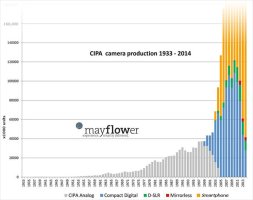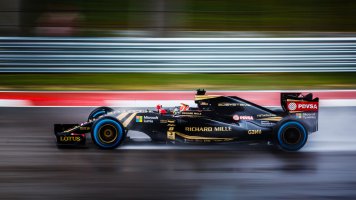You are using an out of date browser. It may not display this or other websites correctly.
You should upgrade or use an alternative browser.
You should upgrade or use an alternative browser.
What’s next from Canon?
- Thread starter Canon Rumors
- Start date
I like OVF for viewing but EVF is great for showing the image immediately so you can quickly make corrections. Sometimes you forget the settings the camera is on and you can have overexposed shots. I tend not to notice the light meter. In EVF it hits you immediately something is wrong . I always thought it a pity that image replay couldn’t be put in the viewfinder of a DSLR.
Upvote
0
So yes, you (and others) are totally right: EVF can do tricks that OVF cannot and I totally admit that these tricks can be considered better. But that wasn't what I was thinking about in my 1st post.
I'm not disagreeing with you. OVF is better / preferable in some situations, e.g. shorter lag & lower power consumption. I'll put good money cameras with OVF are here to stay, same as 35mm film cameras, rangefinders, and large format cameras.
Upvote
0
Only if it has the same DR.The EVF shows you what the sensor sees.
Upvote
0
You could very well be right. We're all just speculating of course. But I kind of interpreted that statement as saying 'Don't panic, you'll still get your EF gear supported with spare parts. Its fully compatible with our new mount so we'll support it for a good amount of time. But we're making a big push in to RF and if it goes like we hope we'll be moving off EF."That's not what "Canon" said. I can understand your confusion because the actual statement was grossly misrepresented by a number of websites seeking to score more hits. But here is what was actually said:
“As you know, last year we launched the RF mount and EOS R system," said Richard Shepherd, pro product marketing senior manager at Canon Europe. "To date we’ve launched ten critically acclaimed lenses, and as it’s a new system we plan to continue this, launching more RF lenses while still fully supporting the EF lens system. And of course, should the market demand it, we are ready to create new EF lenses. But for now, our focus is on RF.”
So all of this nonsense about Canon abandoning the EF mount can be traced to one Canon Europe employee who simply said they were concentrating on RF for the time being.
Given the extensive EF system, it's no surprise they are comfortable pausing new lens development while they build out the RF system.
that last part being the big speculation of course. A statement of reassurance so people don't go sell all their EF gear while its still valuable and before there are RF replacements to keep them in the Canon system.
-Brian
Upvote
0
Upvote
0
I'm interested to see what plans Canon has for any future EF/EF-S lenses and APS-C cameras. As much as we like to get excited about the R5/R6, Canon's APS-C DSLR cameras are still where most people getting into photography, enter the canon ecosystem. Wonder if that elusive 7D mk3 will ever come, or will there be a new EF-S 10-18mm or new 50mm F1.4....
I think it's reasonable to assume no more EF-S lenses ever. I also happen not to expect a 7D3. Lower tier APS-C DSLRs probably have a way to go simply because they represent such a huge chunk of sales and are surely cheaper to develop. I don't know if there will be any more FF DSLRs, both sides of the argument have merits, and it could be Canon hasn't yet decided, and/or that the current global situation will have an impact on their plans. More EF lenses are possible, but I doubt there will be many. The 50mm f/1.4 would surely have been replaced by now if it was ever going to be...
Upvote
0
but then you do not need to crop anymore with Canon offering 600 & 800 f/11 long glass that cost next to nothingOf course I am not saying that. The low Mpx FF sensors are great for high speed data transfer and low noise at high isos. The high Mpx series FF cameras have better reach but slower performance. The 7D series have small APS-C sensors that enable high speed and high reach but at the expense of noise at high iso. The R6 is very different from a 7 series.
Upvote
0
The Sony experts whom I respect rave about the 24 Mpx FF A9II for its spectacular AF for birds in flight, but moan about its lack of reach compared with the A7RIII/IV series. Unless the R6 has the AF capabilities of a Sony A9, it will be of limited use for BIF with much narrower and longer lenses because you need fast shutter speeds and, in my case but not for the more agile, a reasonable field of view to keep faster flying birds in frame. An R5 in crop mode will be a very expensive replacement for the 7DII, but not the R6 as a cheaper one, fine FF camera that it is.While I agree the R6 and 7D are in substantially different niches, you get back some of that 'reach' on the former because it can AF with much narrower apertures, so you can mount longer lenses, teleconverters, and I guess even stacked teleconverters and retain (hopefully useable) AF (and without having to buy the more expensive telephoto lenses). It'll never compete on price and I guess not on weathersealing or ruggedness, but it has the high fps 7-series users are used to. (Obviously the R5 also has these features too, but at a substantially higher cost).
Upvote
0
Only if it has the same DR.
The DR isn't the main factor. Sensor 'sees' in gamma 1.0 so to speak and it's not how we see the world. EVF shows an approximation of how you'd see it through an OVF plus optional exposure simulation. So it's obviously not 'what sensor sees' but not because of the DR.
Upvote
0
This...I like OVF for viewing but EVF is great for showing the image immediately so you can quickly make corrections. Sometimes you forget the settings the camera is on and you can have overexposed shots. I tend not to notice the light meter. In EVF it hits you immediately something is wrong . I always thought it a pity that image replay couldn’t be put in the viewfinder of a DSLR.
When I picked up my first mirrorless this year, the M6 MkII, one thing I couldn't anticipate was the convenience of playback in the viewfinder. I use reading glasses, and it annoyed me to no end when I had the diopter adjusted so I can see the OVF clearly without glasses, then having to put glasses on and off to switch from OVF to LCD to review pics. When I switch back to the 7D MkII, despite it still being superior for wildlife/BIF, I do kind of miss the EVF just for that aspect.
Upvote
0
This...
When I picked up my first mirrorless this year, the M6 MkII, one thing I couldn't anticipate was the convenience of playback in the viewfinder. I use reading glasses, and it annoyed me to no end when I had the diopter adjusted so I can see the OVF clearly without glasses, then having to put glasses on and off to switch from OVF to LCD to review pics. When I switch back to the 7D MkII, despite it still being superior for wildlife/BIF, I do kind of miss the EVF just for that aspect.
I had the same feeling when using the 7D yesterday instead of the RP/M6II, culling pictures is so much easier when it fills your vision.
Upvote
0
The lag is definitely a potential issue, as is the blackout duration. Cranking the EVF up to 120Hz might help, but then the battery life is really going to suffer.Other than the the potential lag of the EVF and battery life, what do you think the R5 is missing for motorsports? With motorsports you panning a lot, so I don't see the lag as causing a significant problem.
I'm sure the R5 is going to be a fine camera for most applications, but I'm still bummed that Canon may not give us one final, amazing 5D.
Attachments
Upvote
0
What I see in the OVF is shown in gamma 1.0 by definition, as well as the rest of the world (shown though passive optical paths, if we disregard the effects of flare).The DR isn't the main factor. Sensor 'sees' in gamma 1.0 so to speak and it's not how we see the world.
The DR compression ("gamma") in the EVF can be applied, but then one would lose the EVF's pseudo-WYSIWYG functionality.
Upvote
0
The sales of interchangeable lens cameras are still higher than historical norms.Out of curiosity, higher in absolute numbers, or in cameras sold per X persons?
Higher price per unit doesn't sound all that surprising to me. Price of electronics has dropped, but there's so much more of it in a modern camera.

This is What the History of Camera Sales Looks Like with Smartphones Included
A few months ago, we shared a chart showing how sales the camera market have changed between 1947 and 2014. The data shows that after a large spike in the
This first chart only goes to 2014 because it is from a 2015 article but nicely illustrates the historical market.
This second link gives later figures and more breakdown.

Case Study: Camera & Photography Industry Statistics
In this article, our team collected the most detailed camera and photography industry statistics. Discover how COVID has affected sales etc
Upvote
0
I did have an issue with my eye going slightly blurry and getting fatigued for a while but I am looking at monitors a lot. Now I would never want to go back to an OVF. Seeing the exposure and focus peeking is brilliant. The R has flaws but also some amazing gains. The only few for me has been rolling shutter, shutter speed and build quality not being very durable. Especially the paint finish and the metal around the mount.Agree.
For me the transition was about half a minute. Now I can hardly bear to look through my 7D2 or 5D4.
Who doesn't want the ability to adjust settings and instantly see what the image is going to look like?
Upvote
0
Similar threads
- Replies
- 96
- Views
- 8K
- Replies
- 51
- Views
- 5K
- Replies
- 166
- Views
- 20K

